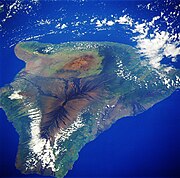
An island (IPA: /ˈaɪlənd/) or isle (/ˈaɪl/) is any piece of land that is completely surrounded by water in two dimensions, above high tide, and isolated from other significant landmasses. Very small islands such as emergent land features on atolls are called islets. A key or cay is another name for a small island or islet. An island in a river or lake may be called an eyot, /ˈaɪət/. There are two main types of islands: continental islands and oceanic islands. There are also artificial islands. A grouping of geographically and/or geologically related islands is called an archipelago.
The word island comes from Old English ī(e)gland (literally, "watery land"). However, the spelling of the word was modified in the 15th century by association with the etymologically unrelated Old French loanword isle.[1]
There is no standard of size which distinguishes islands from islets and continents.
Types
Continental islands

Continental islands are bodies of land that lie on the continental shelf of a continent. Examples include Greenland and Sable Island off North America; Barbados and Trinidad off South America; Great Britain, Ireland and Sicily off Europe; Sumatra and Java off Asia; and New Guinea, Tasmania and Kangaroo Island off Australia.
A special type of continental island is the microcontinental island, which results when a continent is rifted. Examples are Madagascar off Africa; the Kerguelen Islands; and some of the Seychelles.
Another subtype is an island or bar formed by deposition of tiny rocks where a water current loses some of its carrying capacity. An example is barrier islands, which are accumulations of sand deposited by sea currents on the continental shelf. Another example is islands in river deltas or in large rivers. While some are transitory and may disappear if the volume or speed of the current changes, others are stable and long-lived.
Oceanic islands


Oceanic islands are ones that do not sit on continental shelves. They are volcanic in origin. One type of oceanic island is found in a volcanic island arc. These islands arise from volcanoes where the subduction of one plate under another is occurring. Examples include the Mariana Islands, the Aleutian Islands and most of Tonga in the Pacific Ocean. Some of the Lesser Antilles and the South Sandwich Islands are the only Atlantic Ocean examples.
Another type of oceanic island occurs where an oceanic rift reaches the surface. There are two examples: Iceland, which is the world's largest volcanic island, and Jan Mayen — both are in the Atlantic.
A third type of oceanic island is formed over volcanic hotspots. A hotspot is more or less stationary relative to the moving tectonic plate above it, so a chain of islands results as the plate drifts. Over long periods of time, this type of island is eventually eroded and "drowned" by isostatic adjustment, becoming a seamount. Plate movement across a hot-spot produces a line of islands oriented in the direction of the plate movement. An example is the Hawaiian Islands, from Hawaii to Kure, which then extends beneath the sea surface in a more northerly direction as the Emperor Seamounts. Another chain with similar orientation is the Tuamotu Archipelago; its older, northerly trend is the Line Islands. The southernmost chain is the Austral Islands, with its northerly trending part the atolls in the nation of Tuvalu. Tristan da Cunha is an example of a hotspot volcano in the Atlantic Ocean. Another hot spot in the Atlantic is the island of Surtsey, which was formed in 1963.
An atoll is an island formed from a coral reef that has grown on an eroded and submerged volcanic island. The reef rises to the surface of the water and forms a new island. Atolls are typically ring-shaped with a central lagoon. Examples include the Maldives in the Indian Ocean and Line Islands in the Pacific.
When defining islands as pieces of land that are completely surrounded by water, narrow bodies of water like rivers and canals are generally left out of consideration[citation needed]. For instance, in France the Canal du Midi connects the Garonne river to the Mediterranean Sea, thereby completing a continuous water connection from the Atlantic Ocean to the Mediterranean Sea. So technically, the land mass that includes the Iberian Peninsula and the part of France that is south of the Garonne River and the Canal du Midi is completely surrounded by water. For a completely natural example, the Orinoco River splits into two branches near Tamatama, in Amazonas state, Venezuela. The southern branch flows south and joins the Rio Negro, and then the Amazon. Thus, all of the Guianas (Guyana, Suriname, and French Guiana) and substantial parts of Brazil and Venezuela are surrounded by (river or ocean) water. These instances are not generally considered islands.
This also helps explain why Africa-Eurasia can be seen as one continuous landmass (and thus technically the biggest island): generally the Suez Canal is not seen as something that divides the land mass in two.
On the other hand, an island may still be described as such despite the presence of a land bridge, e.g., Singapore and its causeway or the various Dutch delta Islands, such as IJsselmonde. The retaining of the island description may therefore be to some degree simply due to historical reasons - though the land bridges are often of a different geological nature (for example sand instead of stone), and thus the islands remain islands in a more scientific sense as well.



No comments:
Post a Comment